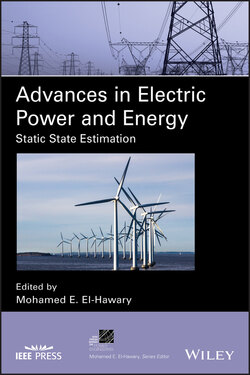Читать книгу Advances in Electric Power and Energy - Группа авторов - Страница 17
1.3 THE NEED FOR STATE ESTIMATION
ОглавлениеSecurity control is the main strategy used in the operation of electric power systems, where actions are taken to prevent an impending emergency, to correct an existing emergency, or to recover from an emergency. Knowing the state of the system under steady‐state conditions is the key to security control.
Control centers may be classified into two types, according to the information base available. In one type of control center, the raw power system data as obtained in real time is an adequate information base for operation. The other type of control center goes beyond the mere acquisition of data. By applying state estimation, a far better and a more comprehensive information base than raw data is obtained.
The importance of the real‐time load flow fed by state estimation lies in its use as basis for security analysis. With the load flow as a base, reference allows analyzing the effects on the system of any contingency event. In contrast, without state estimation, there is not much to be done with raw data except to check it for abnormal values.
A further important feature of state estimation is the ability to detect the presence of bad data (outliers) and to identify which data is in error. Corrections can then be expedited in the field on the faulty instrumentation. Without state estimation, there is no effective, systematic way of finding measurement errors. Some sort of data validation has been attempted wherein power measurements around a bus are summed up and flows at both ends of a branch checked against each other, but these checks apart from being inconclusive end up being too complicated as it has to take into account the topology of the network. Now network topology is handled systematically and correctly by state estimation. Hence for all the checking done by so‐called data validation programs, it is best to go directly to state estimation.
In the modeling of power systems for security control functions, there are usually external networks, i.e. networks or subnetworks, which are not being telemetered by the control center and which are not observable. There are two approaches for estimating the state of these external networks. One approach is to use pseudo‐measurements, based on statistics and forecasts, of the injections at the nodes of the external network. The pseudo-measurements are then assigned relatively low weights and included as part of the measurement set in the state estimation routine. The second approach is to perform the state estimation only on the observable part. The state of the external network is then obtained by finding a load flow solution using the pseudo-measurements as inputs with the boundary node voltages held at the values determined by the state estimation of the observable part.
For bad data identification, early state estimators singled out measurements with the highest values of the weighted residual. Newer bad data identification techniques use both the weighted residual and the normalized residual. Either the values of the normalized residual or the ratios of the normalized ones from the weighted residual are used to identify bad data. Bad data rejection is a time‐consuming procedure at control centers especially if there are more than one measurement in error.
The concept of security control cannot be fully realized without a complete information base that is derived from the voltage magnitudes and phase angles of all buses in a power system obtained via state estimation [1–3].
